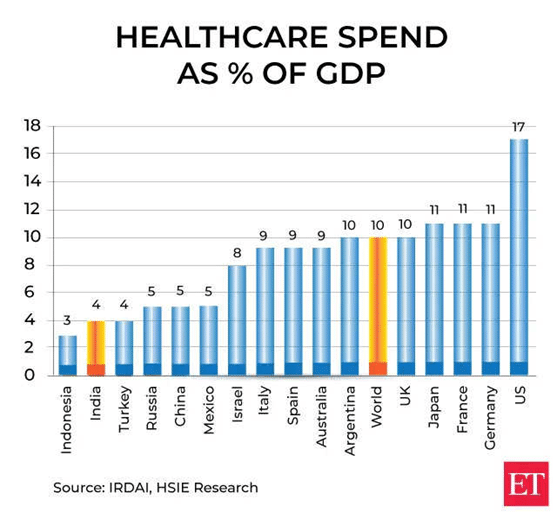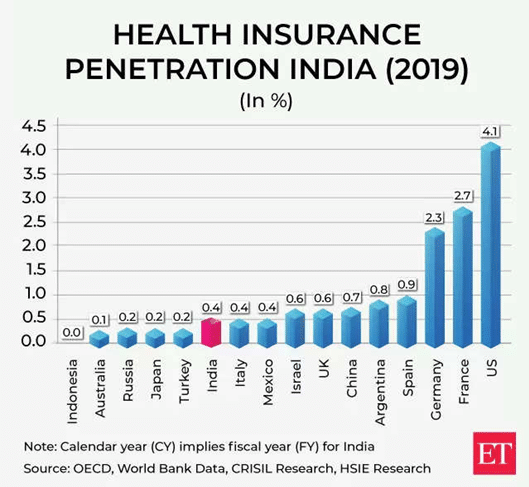SAHI JAWAB FOR INSURANCE
Relevance: GS 3 – Indian Economy and issues relating to planning, mobilization, of resources, growth, development and employment
Why in the news?
- India’s insurance industry is undergoing a major transformation.
- Growth of health insurance is the primary driver of this change.
- The Insurance Regulatory and Development Authority of India (IRDAI) has transitioned from rule-based to principle-based regulations.
- The aim is to achieve universal insurance coverage by 2047.
Insurance market in India
The market has reached $10 billion in gross written premium (GWP), making it the fastest-growing segment.
Factors driving this growth include:
- Population increase.
- High out-of-pocket healthcare costs.
- Increased awareness post-Covid.
- Medical inflation.
- Introduction of stand-alone health insurers (SAHIs).
Health Insurance Premium Trends
- Health insurance premiums tend to increase over time due to ageing policyholders’ health risks.
- In contrast, other insurance sectors see premiums decline due to asset depreciation.
- Health insurance holds a 38% market share in general insurance.
Stand-Alone Health Insurers (SAHIs) Performance
Well-run SAHIs have gained a significant share in the individual health segment. SAHIs have shown:
- 25%-plus growth rates.
- 61% superior loss ratios.
- Extensive agency/hospital networks and strong partnerships. SAHIs excel due to their product focus.
Distribution Channels and Profitability
- Agencies dominate individual health insurance distribution.
- Direct-to-consumer channels have a lower than 95% combined operating ratios.
- SAHIs have penetrated SMEs’ group health products more profitably than traditional group products.
Financial Performance and Sustainability
- Leading SAHIs have recorded underwriting profits recently.
- Factors contributing to their sustainability include:
- Over 80% persistency rates.
- Optimal risk underwriting/pricing interventions, including price hikes.
- Operating leverage driven by scale.
- This leads to a sustainable 25%-plus return on equity at scale.
Innovation and Technology in Health Insurance
- Innovation and tech are driving growth in the health insurance sector.
- Insurers leverage tech for:
- Product innovation.
- Wellness incentives.
- Micro-insurance to deepen penetration.
- This reflects broader healthcare industry trends toward consumerization and advanced tech solutions.
Investments in Advanced Analytics and Data Utilization
- Substantial investments have been made in:
- Predictive analytics.
- Risk mitigation.
- Fraud detection.
- Harnessing data availability.
- Convenience and personalization are driving forces.
- Advanced data and analytics reliance involves efforts from:
- Distribution partners.
Data Sharing and Customisation
- Customers are increasingly comfortable sharing data.
- Insurers are exploring various data sources for:
- Potential incorporation of social footprint mapping to:
- Enhance customer experience.
- Expand coverage to underserved areas and demographics.
IRDAI’s Initiatives and Policy Measures
- IRDAI has catalyzed the transformation with strong policy measures over the last 18 months.
- Key initiatives include:
- Bima Sugam (digital platform).
- Bima Vistaar (comprehensive product).
- Bima Vahaks (last-mile communication network).
- Efforts to improve customer experience and reduce fraud involve:
- Simplifying policy wordings.
- Expense of management.
- Use and file.
- Expanding cashless services.
Introduction of Composite Licences and Sector Growth
- Likely introduction of composite licences will allow insurers to offer integrated life, general, and health insurance solutions.
- This may increase competitive intensity but is expected to catalyse sector growth through:
- New agents.
- Improved agent productivity.
- Expansion into nascent distribution segments.
Financial and Regulatory Catalysts
- Introduction of Ind AS and risk-based solvency in the next few years are long-term catalysts.
- These measures can free up capital and increase ROEs, though they may present short-term volatility.
Investor Interest and Key Deals
- Investor interest remains robust due to:
- Low retail penetration rate of 4% (basis number of lives covered).
- Higher customer engagement metrics.
- High lifetime customer value.
- Attractive returns on equity.
- Key deals include:
- Bupa’s $325 mn-plus investment to increase their shareholding in Niva Bupa.
- ADIA’s investment in Aditya Birla Health Insurance.
M&A Opportunities
- Presence of only five SAHIs adds a meaningful scarcity premium.
- M&A opportunities in the sector include:
- Capital recycling by financial sponsors.
- Greenfield ventures by new entrants or carving out the health insurance business by existing general insurance players.
- Composite licence-driven outcomes for existing players, integrating life and general insurance interests.
Projected Growth and Market Evolution
- The sector is projected to grow at around 20% CAGR over the next five years.
- Regulatory measures have catalysed the sector’s growth, providing a solid platform for future potential.
SAHI Players and Market Expansion
- Best-in-class SAHI players, with strong starting positions and focus on:
- Product innovation.
- Healthcare expertise.
- These players are expected to expand their market share.
- Health insurance players may look towards backward and forward integration, offering value-added healthcare services for a seamless customer experience.
Continued Attraction for Financial Sponsors and Strategic Capital
- With robust growth and favourable financial metrics, the sector will continue to attract financial sponsors and strategic capital.
Source:
https://m.economictimes.com/opinion/et-commentary/sahi-jawab-for-insurance/articleshow/108771203.cms
Mains Question
Discuss the transformative trends and growth prospects in India’s health insurance sector, focusing on regulatory reforms and the role of technology and innovation. (Word limit: 250 words)






